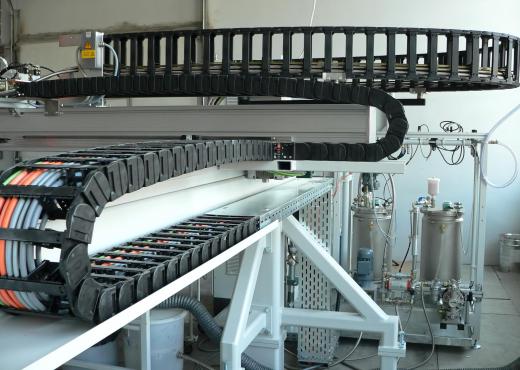At AboutMechanics, we're committed to delivering accurate, trustworthy information. Our expert-authored content is rigorously fact-checked and sourced from credible authorities. Discover how we uphold the highest standards in providing you with reliable knowledge.
What Is a Flexible Conveyor?
A flexible conveyor is a material transport and handling device that shares most of the characteristics of a conventional conveyor but differs in that it is portable and follows no set route. This allows the conveyor to be placed wherever it is needed and turned to follow a route that is most suitable to the immediate loading situation. After use, it can be folded closed for convenient storage. This functionality is the result of its flexible conveyor frame, which is formed as a continuous hinged, scissor-like arrangement, allowing the conveyor to be bent into turns and folded up at will. Several roller arrangements are available, as are powered and gravity-fed varieties.
Conveyor systems are the backbone of many material transport systems. They allow for the continuous and effortless movement of raw materials, finished production items and goods for storage and distribution throughout the relevant installations. Most conventional conveyors follow set routes in unchanging layouts and require considerable planning and effort when any changes to those routes are required. There are, however, many situations that require more flexible solutions that have the latent characteristics and benefits of the permanent conveyor. These situations include multiple bay vehicle loading points, large storage areas or marine loading docks for wide ranges of vessel sizes.

A flexible conveyor is not only mobile and capable of deployment at any point, it also can be turned around obstacles and to accommodate differences in loading and discharge positions. The conveyor also can be lowered and raised at both ends to make up for height disparities between loading and discharge points. This is achieved by replacing the normally rigid side panels of a conventional conveyor with a continuous, hinged scissor frame. The adjustable nature of the flexible conveyor frame allows it to be collapsed or extended and facilitates unequal extension of one or the other of the conveyor sides to accommodate changes in direction.

This flexible frame is mounted on a lower sub-frame that is equipped with casters that allow the whole assembly to be moved around with little effort. The actual transport bed of the flexible conveyor might feature several types of moving elements. These include rollers and rows of skate wheels, depending on the load specifics. The conveyors also can be powered by an electric motor or can be used as gravity feed slides, where goods simply slide down the conveyor bed because of gravity.
AS FEATURED ON:
AS FEATURED ON:












Discuss this Article
Post your comments